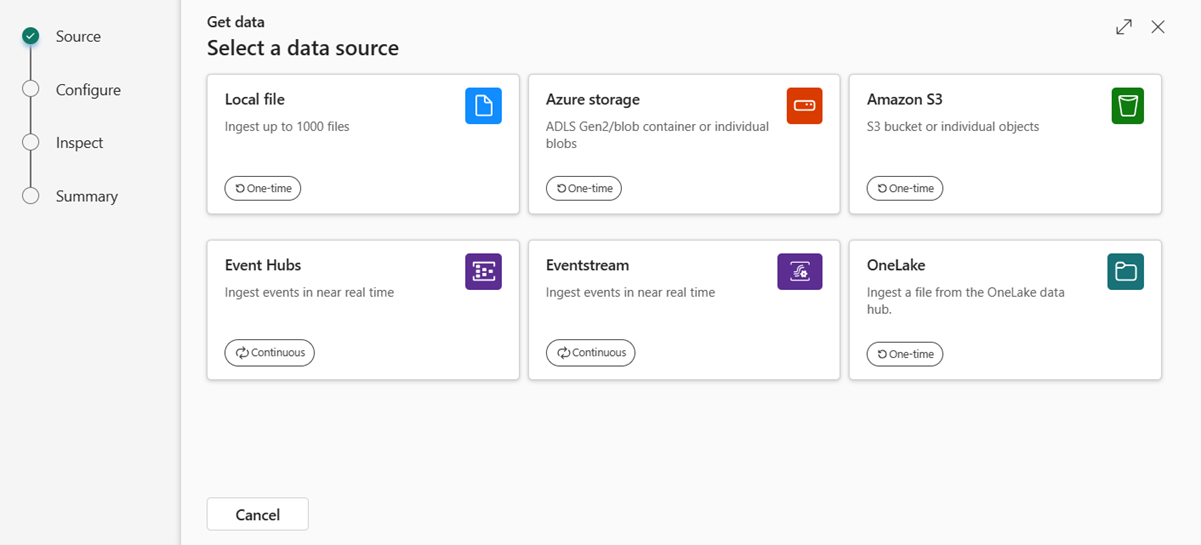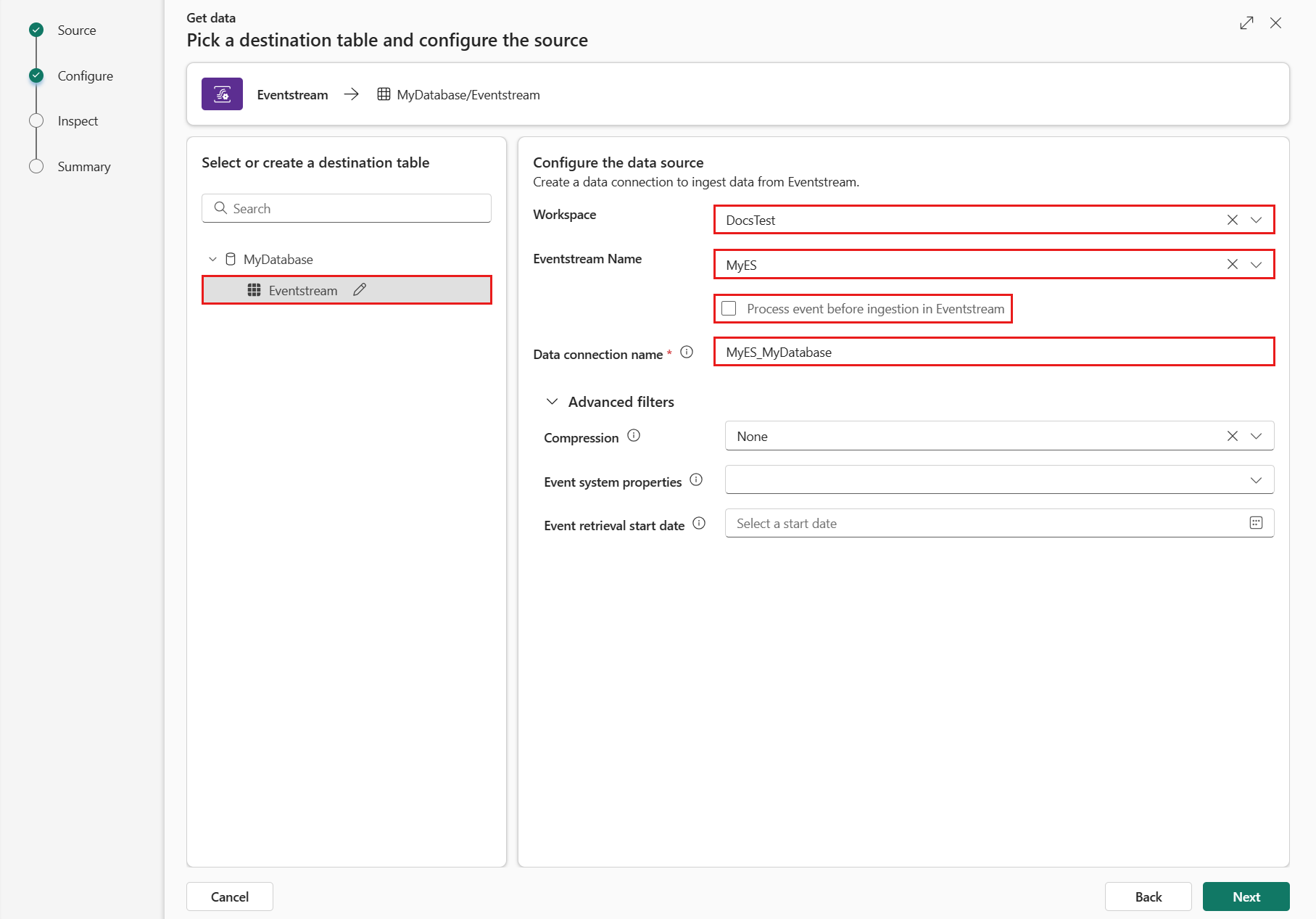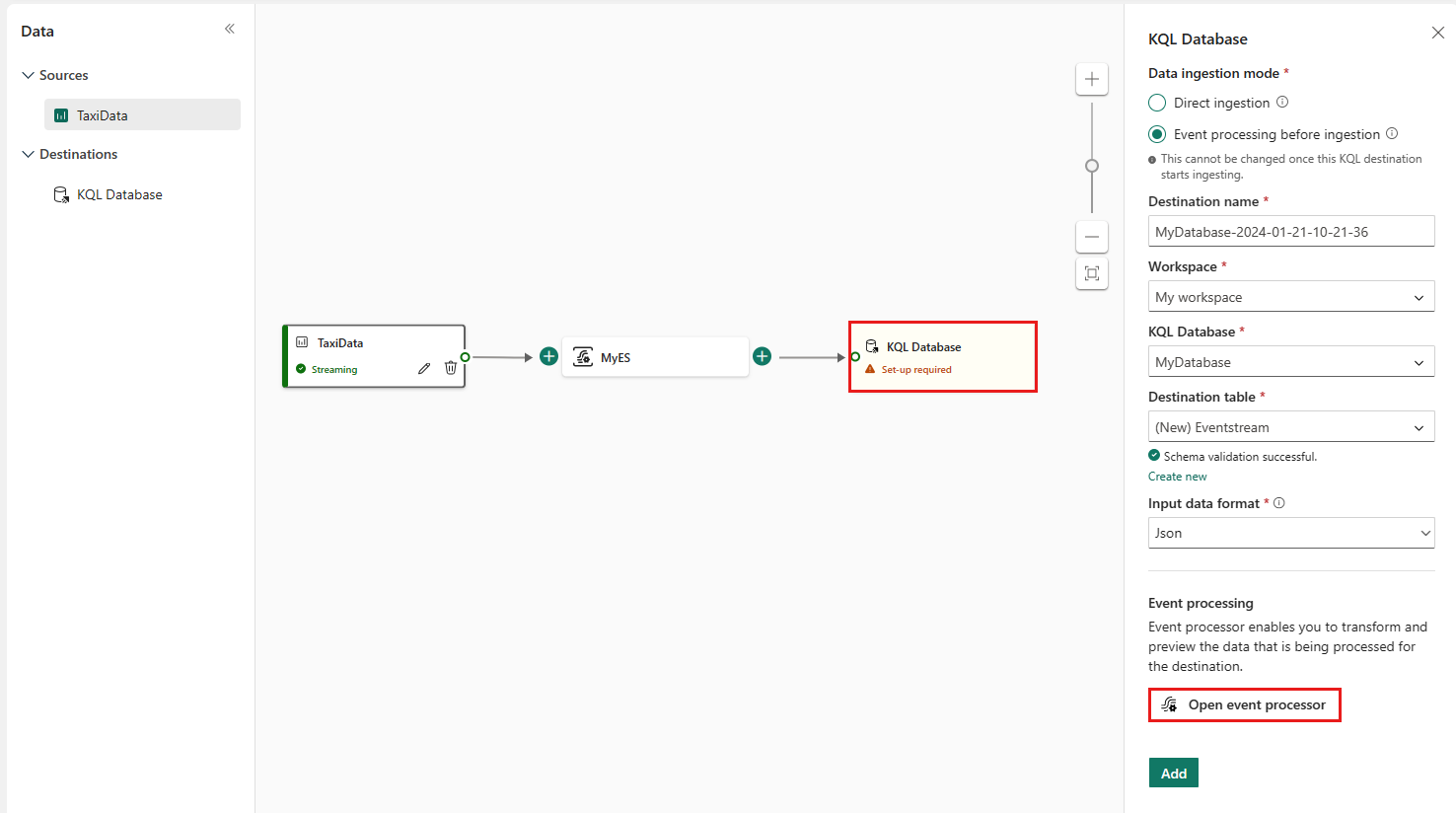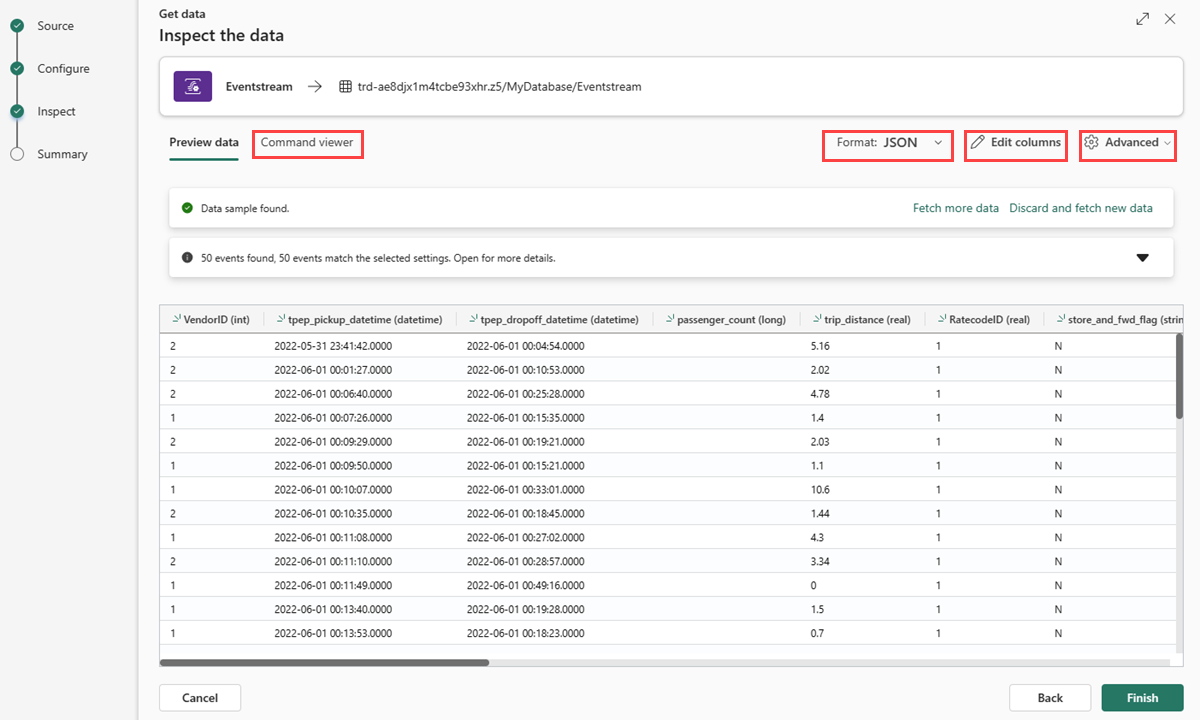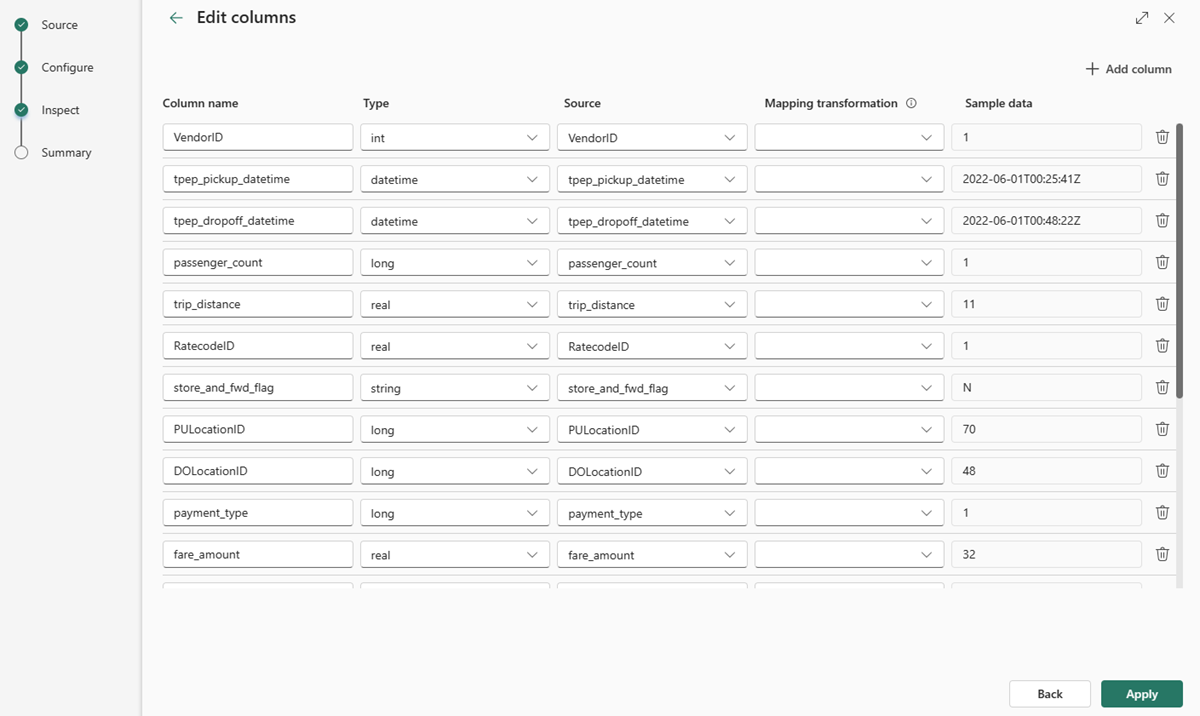Get data from Eventstream
In this article, you learn how to get data from an existing eventstream into either a new or existing table.
To get data from a new eventstream, see Get data from a new eventstream.
Prerequisites
- A workspace with a Microsoft Fabric-enabled capacity
- A KQL database with editing permissions
- An eventstream with a data source
Source
To get data from an eventstream, you need to select the eventstream as your data source. You can select an existing eventstream in the following ways:
On the lower ribbon of your KQL database, either:
From the Get Data dropdown menu, then under Continuous, select Eventstream > Existing Eventstream.
Select Get Data and then in the Get data window, select Eventstream.
Configure
Select a target table. If you want to ingest data into a new table, select + New table and enter a table name.
Note
Table names can be up to 1024 characters including spaces, alphanumeric, hyphens, and underscores. Special characters aren't supported.
Under Configure the data source, fill out the settings using the information in the following table:
Setting Description Workspace The workspace in which your eventstream is located. Select a workspace from the dropdown. Eventstream Name The name of your eventstream. Select an eventstream from the dropdown. Data connection name The name used to reference and manage your data connection in your workspace. The data connection name is automatically filled. Optionally, you can enter a new name. The name can only contain alphanumeric, dash, and dot characters, and be up to 40 characters in length. Process event before ingestion in Eventstream This option allows you to configure data processing before data is ingested into the destination table. If selected, you continue the data ingestion process in Eventstream. For more information, see Process event before ingestion in Eventstream. Advanced filters Compression Data compression of the events, as coming from the event hub. Options are None (default), or Gzip compression. Event system properties If there are multiple records per event message, the system properties are added to the first one. For more information, see Event system properties. Event retrieval start date The data connection retrieves existing events created since the Event retrieval start date. It can only retrieve events retained by the event hub, based on its retention period. The time zone is UTC. If no time is specified, the default time is the time at which the data connection is created. Select Next
Process event before ingestion in Eventstream
The Process event before ingestion in Eventstream option enables you to process the data before it's ingested into the destination table. By selecting this option, the get data process seamlessly continues in Eventstream, with the destination table and data source details automatically populated.
To process event before ingestion in Eventstream:
On the Configure tab, select Process event before ingestion in Eventstream.
In the Process events in Eventstream dialog box, select Continue in Eventstream.
Important
Selecting Continue in Eventstream ends the get data process in Real-Time Analytics and continues in Eventstream with the destination table and data source details automatically populated.
In Eventstream, select the KQL Database destination node, and in the KQL Database pane, verify that Event processing before ingestion is selected and that the destination details are correct.
Select Open event processor to configure the data processing and then select Save. For more information, see Process event data with event processor editor.
Back in the KQL Database pane, select Add to complete the KQL Database destination node setup.
Verify data is ingested into the destination table.
Note
The process event before ingestion in Eventstream process is complete and the remaining steps in this article aren't required.
Inspect
The Inspect tab opens with a preview of the data.
To complete the ingestion process, select Finish.
Optionally:
- Select Command viewer to view and copy the automatic commands generated from your inputs.
- Change the automatically inferred data format by selecting the desired format from the dropdown. Data is read from the event hub in form of EventData objects. Supported formats are CSV, JSON, PSV, SCsv, SOHsv TSV, TXT, and TSVE.
- Edit columns.
- Explore Advanced options based on data type.
Edit columns
Note
- For tabular formats (CSV, TSV, PSV), you can't map a column twice. To map to an existing column, first delete the new column.
- You can't change an existing column type. If you try to map to a column having a different format, you may end up with empty columns.
The changes you can make in a table depend on the following parameters:
- Table type is new or existing
- Mapping type is new or existing
| Table type | Mapping type | Available adjustments |
|---|---|---|
| New table | New mapping | Rename column, change data type, change data source, mapping transformation, add column, delete column |
| Existing table | New mapping | Add column (on which you can then change data type, rename, and update) |
| Existing table | Existing mapping | none |
Mapping transformations
Some data format mappings (Parquet, JSON, and Avro) support simple ingest-time transformations. To apply mapping transformations, create or update a column in the Edit columns window.
Mapping transformations can be performed on a column of type string or datetime, with the source having data type int or long. Supported mapping transformations are:
- DateTimeFromUnixSeconds
- DateTimeFromUnixMilliseconds
- DateTimeFromUnixMicroseconds
- DateTimeFromUnixNanoseconds
Advanced options based on data type
Tabular (CSV, TSV, PSV):
If you're ingesting tabular formats in an existing table, you can select Advanced > Keep table schema. Tabular data doesn't necessarily include the column names that are used to map source data to the existing columns. When this option is checked, mapping is done by-order, and the table schema remains the same. If this option is unchecked, new columns are created for incoming data, regardless of data structure.
To use the first row as column names, select Advanced > First row is column header.
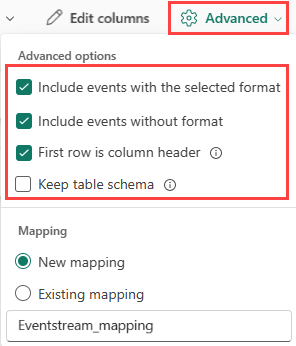
JSON:
To determine column division of JSON data, select Advanced > Nested levels, from 1 to 100.
If you select Advanced > Skip JSON lines with errors, the data is ingested in JSON format. If you leave this check box unselected, the data is ingested in multijson format.
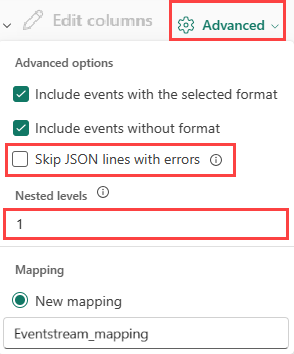
Summary
In the Data preparation window, all three steps are marked with green check marks when data ingestion finishes successfully. You can select a card to query, drop the ingested data, or see a dashboard of your ingestion summary. Select Close to close the window.
Related content
- To manage your database, see Manage data
- To create, store, and export queries, see Query data in a KQL queryset
Feedback
Coming soon: Throughout 2024 we will be phasing out GitHub Issues as the feedback mechanism for content and replacing it with a new feedback system. For more information see: https://aka.ms/ContentUserFeedback.
Submit and view feedback for
